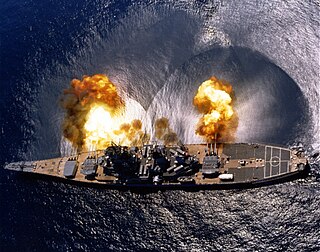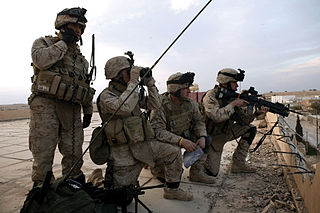
A battalion is a military unit, typically consisting of up to one thousand soldiers. Commanded by a lieutenant colonel and subdivided into several companies, each typically commanded by a major or a captain. The typical battalion is built from three operational companies, one weapons company and one headquarters company. In some countries, battalions are exclusively infantry, while in others battalions are unit-level organizations.

Naval gunfire support (NGFS), also known as naval surface fire support (NSFS), or shore bombardment, is the use of naval artillery to provide fire support for amphibious assault and other troops operating within their range. NGFS is one of several disciplines encompassed by the term naval fires. Modern naval gunfire support is one of the three main components of amphibious warfare assault operations support, along with aircraft and ship-launched land-attack missiles. Shipborne guns have been used against shore defences since medieval naval warfare.

Force Reconnaissance (FORECON) are special operations capable forces companies unit of the United States Marine Corps and part of the Fleet Marine Force that provide gathering military intelligence to the command element of the Marine Air-Ground Task Force (MAGTF). Force Reconnaissance companies report to the Marine expeditionary force (MEF) and provide amphibious reconnaissance to support amphibious warfare operations, deep reconnaissance, direct action against important strategic or tactical goals, irregular warfare, ISTAR, long-range penetration, and special reconnaissance during large-scale operations.

An artillery observer, artillery spotter, or forward observer (FO) is a soldier responsible for directing artillery and mortar fire support onto a target. An artillery observer usually accompanies a tank or infantry unit. Spotters ensure that indirect fire hits targets which those at a fire support base cannot see.

The I Marine Expeditionary Force is a Marine Air Ground Task Force (MAGTF) of the United States Marine Corps primarily composed of the 1st Marine Division, 3rd Marine Aircraft Wing, and 1st Marine Logistics Group. It is based at Marine Corps Base Camp Pendleton.

A tactical air control party, commonly abbreviated TACP, is a small team of military personnel who provide coordination between aircraft and ground forces when providing close air support.
Oceanview was a U.S. Marine Air Naval Gunfire Liaison Company (ANGLICO) observation post located on the coast some 10 km north of the Cua Viet River in Quang Tri Province and just south of the Vietnamese Demilitarized Zone (DMZ). It was a very isolated spot and could be reached only by Amtrac or helicopter.
100th (Yeomanry) Regiment Royal Artillery is a reserve unit of the British Army that provides tactical air control parties, naval gunnery liaison officers, specialist staff officers and gunnery instructors.

Air Naval Gunfire Liaison Company (ANGLICO) is an airborne fire support and liaison unit of the United States Marine Corps. The mission of ANGLICO is "To provide Marine Air-Ground Task Force (MAGTF) Commanders a liaison capability to plan, coordinate, and conduct terminal control of fires in support of joint, allied, and coalition forces. Per this mission statement, ANGLICOs are not designed to support U.S. Marine Corps maneuver elements. Instead, the doctrinal purpose of ANGLICO is to provide fire support and coordination in support of units adjacent to the MAGTF.
In the United States Marine Corps, a Marine air–ground task force is the principal organization for all missions across the range of military operations. MAGTFs are a balanced air–ground, combined arms task organization of Marine Corps forces under a single commander that is structured to accomplish a specific mission. The MAGTF was formalized by the publishing of Marine Corps Order 3120.3 in December 1963, "The Marine Corps in the National Defense, MCDP 1-0". It stated:
A Marine air–ground task force with separate air ground headquarters is normally formed for combat operations and training exercises in which substantial combat forces of both Marine aviation and Marine ground units are included in the task organization of participating Marine forces.
148 (Meiktila) Commando Forward Observation Battery is a specialist Naval Gunfire Support Forward Observation (NGSFO) unit within 29 Commando Regiment Royal Artillery of UK Commando Force Royal Marines.

The United States Marine Corps is organized within the Department of the Navy, which is led by the Secretary of the Navy (SECNAV). The most senior Marine commissioned officer is the Commandant of the Marine Corps, responsible for organizing, recruiting, training, and equipping the Marine Corps so that it is ready for operation under the command of the unified combatant commanders. The Marine Corps is organized into four principal subdivisions: Headquarters Marine Corps, the Operating Forces, the Supporting Establishment, and the Marine Forces Reserve.
In the United States Marine Corps, the ground combat element (GCE) is the land force of a Marine Air-Ground Task Force (MAGTF). It provides power projection and force for the MAGTF.
The Fleet Landing Exercises, or FLEX were amphibious landing exercises conducted by the United States Navy and United States Marine Corps between 1935 and 1941. The purpose of these exercises was to formulate a workable amphibious warfare doctrine. The development of the necessary craft and other equipment, and the proper tactical deployment of them were also results. Finally, the exercises demonstrated the usefulness of a standing body of Marines, the Fleet Marine Force, specially prepared for amphibious expeditions.
The United States Marine Corps is tasked by Department of Defense directive to "conduct complex expeditionary operations in the urban littorals and other challenging environments" and "conduct amphibious operations, including engagement, crisis response, and power projection operations to assure access." Before 2006, the Marine Corps was the only branch of the Armed Forces that did not have any of its special warfare elements participating in the United States Special Operations Command (USSOCOM), due to confining its special operations capabilities only for the purpose to the Fleet Marine Force.

The bombardment of Cherbourg took place on June 25, 1944, during World War II, when ships from the United States Navy and the British Royal Navy attacked German fortifications in and near the city, firing in support of U.S. Army units that were engaged in the Battle of Cherbourg. In doing so, the Allied naval forces engaged in a series of duels with coastal batteries and provided close support to infantry as they fought to gain control of the city. The bombardment was initially scheduled to last just two hours but it was later extended by an hour to support army units attempting to break into Cherbourg's city streets. After the bombardment, German resistance lasted until June 29, when the port was captured by the Allies. Afterwards, the task of clearing the port for use lasted several weeks.
Forward observers in the U.S. military are artillery observers who carry the Military Occupational Specialty designator of 13F in the United States Army and 0861 in the United States Marine Corps. They are officially called "joint fire support specialists" in the U.S. Army and "fire support marines" in the U.S. Marine Corps. They are colloquially known as "FiSTers", regardless of whether they are members of a FiST. A battalion fire support officer (FSO) is the officer in charge of a battalion fire support element.

Donald McPherrin Weller was a decorated officer of the United States Marine Corps with the rank of major general. He is most noted as pioneer of Naval gunfire support and author of many publications on this topic. Weller also commanded 3rd Marine Division and ended his career as deputy commander, Fleet Marine Force Pacific.

A joint assault signal company (JASCO) was a joint service unit that provided ship to shore and air to ground communications to coordinate and control naval gunfire and close air support for American land forces during World War II. They were composed of specially trained officers and enlisted personnel from the Navy, Marines, and Army. The Army component was composed of Air Liaison Officers and enlisted communications technicians. JASCOs were created in the Pacific because previous small communication teams were ineffective and only served to clutter communications. After the costly Battle of Tarawa, the need for centralized command and control of air and naval fire support between the Navy, Marines, and Army was seen. Major General Alexander Vandegrift formed the Joint Assault Signal Companies based on his experiences in the Guadalcanal campaign. Navajo and other Native American code talkers were often attached to JASCOs.











